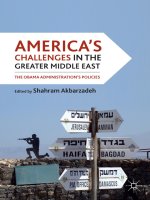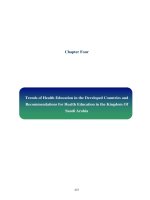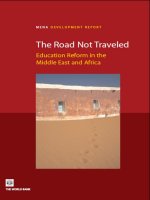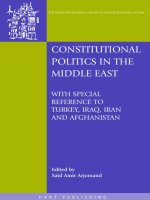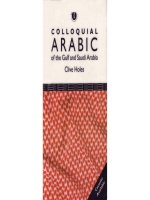saudi arabia (middle east in focus)
Bạn đang xem bản rút gọn của tài liệu. Xem và tải ngay bản đầy đủ của tài liệu tại đây (4.39 MB, 557 trang )
SAUDI ARABIA
Titles in ABC-CLIO’s Latin America in Focus Series
Venezuela Elizabeth Gackstetter Nichols and Kimberly J. Morse
Titles in ABC-CLIO’s Africa in Focus Series
Eritrea Mussie Tesfagiorgis G.
Ethiopia Paulos Milkias
Titles in ABC-CLIO’s Asia in Focus Series
China Robert André LaFleur, Editor
Japan Lucien Ellington, Editor
The Korea s Mary E. Connor, Editor
SAUDI ARABIA
Sherifa Zuhur
Middle East in Focus
Copyright 2011 by ABC-CLIO, LLC
All rights reserved. No part of this publication may be reproduced, stored in a retrieval system,
or transmitted, in any form or by any means, electronic, mechanical, photocopying, recording,
or otherwise, except for the inclusion of brief quotations in a review, without prior permission in
writing from the publisher.
Library of Congress Cataloging-in-Publication Data
Zuhur, Sherifa.
Saudi Arabia / Sherifa Zuhur.
p. cm. — (Middle East in focus)
Includes bibliographical references and index.
ISBN 978-1-59884-571-6 (hardcopy : alk. paper)—ISBN 978-1-59884-572-3 (ebook)
1. Saudi Arabia. I. Title.
DS204.Z84 2011
953.8—dc23 2011019833
ISBN: 978-1-59884-571-6
EISBN: 978-1-59884-572-3
15 14 13 12 11 1 2 3 4 5
This book is also available on the World Wide Web as an eBook.
Visit www.abc-clio.com for details.
ABC-CLIO, LLC
130 Cremona Drive, P.O. Box 1911
Santa Barbara, California 93116-1911
This book is printed on acid-free paper
Manufactured in the United States of America
v
Contents
About the Author, xi
Preface, xiii
Acknowledgments, xvii
1 GEOGRAPHY, 1
The Geology of Petroleum, 5
The Deserts, 7
Water, 9
Climate, 10
Fauna, 10
Flora, 11
Environment and Pollution, 12
Historic and Modern Divisions, 12
2 HISTORY, 17
Timeline, 17
The Rise of Islam, 32
Muslim Dynasties, 35
Later Muslim Dynasties and the Arabian Region, 37
Muhammad ibn ‘Abd al-Wahhab and the First Sa‘udi State, 39
The Second Sa‘udi Realm (1824–1891), 41
Contents
vi
|
‘Abd al-‘Aziz al-Sa‘ud (Ibn Sa‘ud) and the Forging of Saudi Arabia, 42
King Sa‘ud ibn ‘Abd al-‘Aziz, 49
The Reign of Faysal ibn ‘Abd al-‘Aziz, 53
The Reign of Khalid ibn ‘Abd al-‘Aziz, 58
Saudi Arabia under King Fahd, 62
The Gulf War, 65
Reactions to the Gulf War, 66
The War on Terrorism and the Global War on Terror, 68
The Reign of King ‘Abdullah, 69
3 GOVERNMENT AND POLITICS, 79
The King, 81
The Crown Prince, 88
The Royal Diwan, 89
The Council of Ministers, 90
The Majlis al-Shura, 91
Judiciary and Legal System, 93
Civil Service Board and Independent Agencies, 94
Regional and Municipal Government, 95
The ‘Ulama, 9 5
Family and Tribal Infl uences, 97
National (Meeting for Intellectual) Dialogue, 100
Domestic Political Issues, 101
Foreign Policy, 103
Broader Saudi Arabian Foreign Policy, 125
4 ECONOMY, 137
Overview, 137
Economic Planning, 140
Industry, 144
The Private Sector and the State, 158
Labor, 160
Trade and Finance, 164
Taxation, 166
Investment, 167
Banking and Financial Systems, 168
Economic Outreach and Aid, 169
5 SOCIETY, 175
Religion and Law, 175
Islamic Law, 180
Islamic Duties, 181
Contents
|
vii
Muhammad ibn ‘Abd al-Wahhab, 186
The ‘Ulama, 1 8 9
Governmental Religious Departments, 190
Shi‘a Muslims in Saudi Arabia, 193
Other Competing Ideologies, 194
Social Classes and Ethnicity, 199
Overview, 199
Bias in Social Information, 200
Modern Societal Studies, 201
Ethnicity versus Nationality, 201
Tribalism, 202
Endogamy, 202
Tribal Values, 203
Religious Elite, 203
Merchants, 203
Religious Minorities, 204
Slavery, 204
Racial Relations, 205
Traditional Social Values, 206
Age, 207
Gender and Social Status, 208
Modernization and Society, 209
Foreign Workers, 209
Poverty, 212
The Royal Family, 212
Women and Marriage, 218
Women and Education, 221
Restrictions, 222
Expansion, 223
Employment, 223
Rules and Expectations, 224
Guardianship, 225
Guardianship and Marriage, 225
Social Equivalence and Polygyny, 227
Divorce, 228
Abuse, 229
Rape, 229
Dress, 229
Servants, 230
Education, 232
Overview, 233
Universities, 236
Separate Gender Education, 238
Contents
viii
|
International Schools, 239
Education and Aramco, 239
Shi‘a Higher Education and Activism, 240
Islamic Education, 240
Critiques of Islamic Education, 241
Learning by Other Means, 242
6 CULTURE, 245
Language, 245
Language Features, 248
Numbers, 250
Features of Arabic, 251
Etiquette, 256
Co ee, 261
Gestures, 262
Gifts, 262
Clothing, 262
Deportment and Segregation of the Sexes, 264
Business, 265
Bargaining, 266
Photographs, 267
Weddings and Funerals, 267
Literature, 268
The Impact of the Qur’an, 270
Ghazal Poetry, 270
Folk or Vernacular Poetry and Lyrics, 271
Early-Modern Arab Literature, 272
Modern Poetry, Novels, and Short Stories, 272
Theater and Drama, 277
Later Novels, 278
Theater in Private Spaces, 279
Visual Art and Film, 281
Photography, 283
Young Artists, 283
Film, 284
Music and Dance, 288
Music: General Features, 290
Popular Music Industry, 292
Traditional Musical Forms, 292
Large-Ensemble Music, 296
Styles of Hijaz and Asir, 297
Dance, 298
Contents
|
ix
Religious Music, 299
Songs of Pilgrimage, 301
Food, 305
Sports and Leisure, 317
Sports, 317
Leisure and Entertainment, 325
Popular Culture, 328
Amthal, 3 2 9
Jokes, Nawadir , and Short Tales, 330
Superstitions, 330
Games, 330
Tribal Law and Mediation, 331
Tribal and Traditional Medicine, 332
Popular Occasions, 334
Clothing and Historic Costume, 334
Architecture, 342
The Mosque, 343
Markets, 345
General Features of the Hijaz, 346
Asir and Abha, 349
Najd, 349
Eastern Province, 351
7 CONTEMPORARY ISSUES, 355
Defense, 355
Islamist Opposition and Terrorism, 361
Health, 368
Women and Social Transformation, 372
Media, Freedom of Speech, and Censorship, 374
Human Rights, 376
Capital Punishment, 377
Glossary, 385
Facts and Figures, 399
Major Saudi Arabian Holidays, 415
Country-Related Organizations, 419
Annotated Bibliography, 445
Thematic Index, 495
Index, 519
xi
About the Author
Sherifa Zuhur is a professor of Islamic and Middle Eastern studies, history, and
national security a airs, formerly of the Strategic Studies Institute, U.S. Army War
College. She directs the Institute of Middle Eastern, Islamic and Strategic Stud-
ies and has written 17 books and monographs, including Saudi Arabia: Islamism,
Political Reform and the Global War on Terror , and Ideological and Motivational
Factors in the Defusing of Radical Islamist Violence . She was a member of a NATO
research team focusing on antiterrorism and wrote white papers and book chapters
such as “Decreasing Violence in Saudi Arabia and Beyond” (in Pick, Speckhard, and
Jacuch, eds., 2010) about Saudi Arabia. She is a former president of the Association
of Middle East Women’s Studies and an editor of the Review of Middle East Stud-
ies , and she holds a BA in political science and Arabic and Arabic literature, an MA
in Islamic studies, and a PhD in history, all from the University of California, Los
Angeles.
xiii
Preface
All books are written at particular historical moments. Especially in nonfi ction
writing, special concerns that color media, governmental, or scholarly publications
are refl ected, if not in the author’s intent, in the questions formulated by editors and
readers. This is true of both contemporary and historical writings. I want to note
that both immediate and uncertain political currents are now impacting Saudi Ara-
bia’s neighbors in the Middle East; the Tunisians have ousted their long-time presi-
dent, the Egyptians have overthrown Hosni Mubarak and are trying to implement a
democratic and pluralist political system, Yemeni president Ali Abdullah Saleh has
left Yemen for Saudi Arabia after months of protests when he was wounded in an
attack, the Libyan people are battling the loyalists of Col. Mu‘ammar Qadhdhafi ,
and Syrians, Bahrainis, Omanis, Moroccans, Algerians, and Jordanians are calling
for reform or changes in government. Saudi Arabian e orts to organize protests
were anticipated and repressed, but it seems unlikely that the country will remain
untouched by the regional fever for political change.
My second prefatory note is a general one; one fi nds far too schizophrenic a treat-
ment of Saudi Arabia at this historical juncture. Portraits are painted with great love
or sharp distaste, so strong as to cover over a truer panorama. Saudi Arabia is far
too often essentialized as an unchanging archaic and exotic desert monarchy whose
primary importance to the Western world is oil and/or Islamic extremism. Over many
years, I have found it fascinating that so many outspoken American critics of Saudi
Arabia were consulted at expert meetings in Washington, DC, primarily on the basis
of their profound dislike of the country, which some had never visited. On the other
xiv
|
Preface
hand, diplomats to the country have often served as experts, as they had acquired
information inaccessible to others.
Just as great antipathy for Saudi Arabia and all things Saudi is expressed in some
circles, others are at turns defensive or nostalgic, or o er apologia without much use-
ful analysis or comparative perspectives. Nothing is ever so black or white as Saudi
Arabia has been painted! The polemical manner in which Saudi Arabia is covered
makes it di cult for a reader to acquire basic familiarity with the country’s features.
Contemporary scholarship in the Arab and Muslim worlds is also divided on the
question of Saudi Arabia, and the country’s own scholars are often unfortunately
bound by prudence, discipline, bonds of employment or kinship, or justifi able suspi-
cions about the motives of outsiders. This has complicated my task. As a responsible
scholar, I have to write about subjects such as political succession in Saudi Arabia
and the potential for struggle over that issue. However, Saudi Arabian scholars and
writers are not free to share their insights on that issue, at least not at this time. About
a month before I wrote this preface, Mohammed al-Abdulkarim, a Saudi Arabian
professor of law, was arrested for publishing an article on royal succession and the
potential for struggles over power within the royal family. Hatoon al-Fassi, a Saudi
Arabian historian, was warned o at fi rst by her editor at a Saudi Arabian newspaper
for her depiction of Arab governments’ response to the Tunisian revolution ( KQED
News , January 26, 2011). Now, if Saudi Arabian intellectuals cannot speak or write
freely, then, unfortunately, external reportage from Western sources far less familiar
with the dynamics of Saudi Arabian or other Arab nations will continue to shape
opinions about their country.
Ma fi mushkila! (No problem! A typical Saudi response and subtle recommenda-
tion to relax and lighten up!) This book does not pretend to remedy these bifurcated
perspectives and the struggle over the nation’s image. It is, however, intended as a
guide to uncover information about the real, multifaceted modern nation using an
interdisciplinary approach and resources. My background and professional inter-
ests in Islamic studies, politics, security issues, and other interests in music, poetry,
popular culture, gender relations, political economy, and race helped me formulate
thoughts in brief on these subjects, although I could only hurriedly mention many
that are covered in depth elsewhere. The book’s format required coverage of so many
other topics in order to make sense of contemporary Saudi Arabia that the reader
would be well advised to continue her or his exploration of this fascinating country
with materials suggested in this work and others.
The fi rst chapter, “Geography,” introduces readers to the physical and environ-
mental basis of the Kingdom of Saudi Arabia. This includes its climate, weather pat-
terns, major land forms, water sources, fauna, fl ora, and the scientifi c understanding
of oil formation. Much of the wonderful photography and scientifi c studies of the
landscape, geology, and fauna have come from Saudi Aramco. The second chapter,
“History,” provides the essential details of Arabia’s ancient past, the advent of Islam,
and the area’s condition in the premodern era. Greater emphasis is put on contem-
porary history for it will greatly aid in understanding the nuances of Saudi Ara-
bia’s politics, international relations, economic policies, and laws. The third chapter,
“Government and Politics,” begins with an overview of political structures and roles.
Preface
|
xv
I added a section on Saudi Arabia’s international relations with Arab, Muslim, and
foreign partners because of my interests and daily involvement in such issues over the
last decade. Also, I believe that to study a country in isolation, without considering
the impact of subregional, regional, and global infl uences on it, and vice versa, can
be misleading and is a type of essentialism.
The fourth chapter, “Economy,” provides an introduction to the country’s
resources, oil and other industries, agriculture, labor situation, and fi nancial struc-
tures. The fi fth chapter, “Society,” begins with a section on Islam, the reform move-
ment of Muhammad ibn ‘Abd al-Wahhab, and today’s religious structures, with
some attention to the functioning of Islamic law in Saudi Arabia. I have briefl y
mentioned other ideological trends at the end of the subsection. The second subsec-
tion, on social class and ethnicity, reveals that social divisions in Saudi Arabia take
various forms. Some predate the oil boom and arose from tribal, geographic, or
occupational a liations and gender. Slavery played an important role in the Ara-
bian Peninsula that has not yet been fully explored or described. Other divisions are
modern, arising since King ‘Abd al-‘Aziz al-Sa‘ud’s creation of the nation and dur-
ing its governance by his descendants, whether from the need for foreign labor, the
youth bulge in Saudi Arabia’s demography, or disputes over the appropriate role of
religion in society. The next subsection deals with women’s roles and history in Saudi
Arabia and with marriage. As many international groups have accused Saudi Arabia
of suppressing women’s rights, it is important to understand which limitations have
the greatest impact on women’s lives and to note the intense value placed on family
ties and cohesion. Education is the subject of the next subsection. This sector has
greatly expanded due to governmental policy, and its quality must improve as well.
Also, to echo Dr. Khalid Alnowaiser, “reforms depend on a tolerant and informed
citizenry,” and thus reforming religious education to seek the “advancement of the
human race” ( Arab News , January 10, 2011) rather than replicating “memorizers” is
a key, albeit disputed, goal.
The sixth chapter, “Culture,” is composed of subsections on the Arabic language
and Saudi dialects; social etiquette; Arabian and Saudi Arabian literature of the past
and present, including poetry and prose; visual art; photography and fi lms; music,
dance, and public ceremonies or performances; Saudi Arabian cuisine and food
traditions; and leisure activities, including popular sports in the kingdom. Another
subsection is on popular cultural traditions not treated earlier, including proverbs,
folktales, and superstitions, ‘urf (customary or tribal law), customary and Islamic
medicine, herbology or ethnobotany, popular gatherings, and traditional dress and
its construction, which di er by region. This is a part of the living Saudi Arabia
that is being rapidly forgotten and may be in danger of being relegated to obscure
anthropological studies or museum exhibits.
The fi nal chapter, “Contemporary Issues,” of the book concerns subjects that may
be controversial or that are of particular interest today. Many of these can be viewed
alternatively as new stages of development; rea rmation of the rulers’ promise of
security to their subjects, who in turn promise loyalty but have yet to fully acquire
civil rights and responsibilities; struggles over the defi nition of Saudi Arabian na-
tionhood; or struggles emanating from global confl icts and alliances. This chapter
Preface
xvi
|
sets out Saudi Arabia’s defense capabilities and weapons capacity as opposed to its
relatively small military. This high weapons to low defense manpower ratio is the
very reason that the kingdom requires coordination with and backing by an external
power (and has led to the extremists’ claim that it is overly infl uenced by the United
States). The rise of violent extremism in Saudi Arabia over the last decade and the
government’s counterterrorism e orts, which I have written about elsewhere, are
then described. To some degree, this problem has spilled over into Yemen. The next
subsection covers health issues in the kingdom as an aspect of national develop-
ment. The development of women’s capabilities is also discussed, as well as the role
of the women in the royal family, who are often overlooked by the international
press. Saudi Arabia’s media establishment and government censorship are, along
with human rights issues, lightning rods for international criticism. Human rights
are considered in the broadest meaning of the term; therefore, the large numbers of
impoverished and homeless persons and children are mentioned along with issues
of criminal justice. My intent is primarily to direct the reader toward issues of con-
temporary concern that are documented and likely to generate further public policy
e orts.
A glossary of Arabic terms used throughout the text has been provided, and read-
ers are advised to turn to this section whenever puzzled by a repeated usage of an Ara-
bic term. Saudi Arabia’s major holidays are described, and a section on organizations
in Saudi Arabia includes some bilateral organizations, business portals, important
organizations of the Saudi Arabian government, and a few examples of charitable
and humanitarian organizations. Some of the most important international organi-
zations of which Saudi Arabia is a member are listed, and because political parties
are forbidden in Saudi Arabia, a few of the country’s opposition groups are also
briefl y described.
I have included a bibliography that is intended to represent the many issues cov-
ered in this volume; in addition, a brief listing of musical recordings is provided
for those who are curious about that aspect of cultural production. There is a vast
literature on Saudi Arabia, and I have excluded a great deal of the works in Arabic
because this series is geared toward English-language readers (I do urge readers to
try, if they can, to learn this remarkable language, because without it, they may be
missing about 80 percent of the available information on Saudi Arabia and much
of the nuance.) The sidebars include some items of particular interest, and tables
and additional information that should help provide a more detailed picture of the
country’s status and development are included in the back matter.
xvii
Acknowledgments
A number of acknowledgments are in order, as I have acquired various intellectual
and personal debts while working on this book. I thank ABC-CLIO editors Lynn
Jurgensen, Evan Brown, and Christian Green, who brought this book to life; Spencer
Tucker, who had previously convinced me to work with him on other large encyclo-
pedia projects for ABC-CLIO; and the copyediting team.
I could never have undertaken this book without the generosity of many individu-
als, scholars, and o cials who live in Saudi Arabia or are connected to the Saudi
Arabian diplomatic corps. Among them I want to thank the perennially supportive
Hassan al-Hussaini, my former classmate and fellow Bruin Abdullah al-Askar, the
faculty and members of the Diplomatic Institute in the Saudi Arabian Ministry of
Foreign A airs, Elizabeth Hall, Dr. Abdullah Musa Al-Tayer, Elham Al Ateeq,
Afaf Alhamdan, Huda Al-Jeraisy, Dr. Abdulmohsin Al-Akkas, Mohamed Ayaz,
Desmond Carr, Abdulrahman al-Hadlag, Khalil al-Khalil, Muhammad Al Eissa,
Sherry Cooper, Kay Campbell, Nadia al-Baeshen, and others not named here. When
I arrived at the U.S. Army War College, I was supposed to embark on a large research
project on Iraq. My supervisor prevented me from writing what I had intended to
write, and I decided to work on a brief study of Saudi Arabia and its signifi cance to
the U.S. defense and political sectors. My interests deepened, and I began a more
detailed case study of the Islamist opposition movement in Saudi Arabia, only to be
forbidden from publishing it there. They say that when God closes a door, he opens
a window, and so other venues for my work presented themselves, allowing me to
review many special materials on Saudi Arabia. As I explored Saudi Arabia’s cul-
ture and circumstances, I felt strongly that the Saudi bashing in the U.S. media was
Acknowledgments
xviii
|
impeding an understanding of that country, and I made an e ort, supported by Lt.
Gen. David Huntoon and certain War College faculty, to bring Amb. H. R. H. Prince
Turki Al-Faysal Al-Sa‘ud to speak twice to the entire class and our international
fellows. My travel to the kingdom from 2005 through 2008 for research prior to
this book was supported by the U.S. government; however, the standard disclaimer
applies—the government is no way responsible for those earlier research works, my
opinions, or this book. Thanks are also due to Laurie Fenstermacher of the U.S. Air
Force Research Laboratory, Anne Speckhard, Tom Pick, and others who encour-
aged me to pursue my “alternative” idea that Muslims may craft their own responses
to terrorism and extremism, sometimes more e ectively than external actors.
I have benefi ted greatly from the insights and published works of many special-
ists on Saudi Arabia, who include Donald Cole, Eleanor Doumato, Soraya Altorki,
Gregory Gause, Abdullah al-Askar, Khalid al-Dakhil, Natana Delong-Bas, Tim
Niblock, Kay Hardy Campbell, Gwen Okruhlik, William Ochenswald, David Com-
mins, Madawi al-Rasheed, Thomas Hegghammer, Christopher Boucek, Anthony
Cordesman, Nawaf Obaid, John Duke Anthony, Lisa A. Urkevitch, Stèphane La-
croix, the late Sadekka Arebi, and others named in the book. As’ad AbuKhalil and
Mona Eltahaway are vociferous critics of the Saudi Arabian government (not its
people), but their attention to certain issues was a very constructive starting point
for my own review.
I want to thank my son, Jean-Paul, and my husband, Ahmed, for putting up
with an intense period of writing and the uncertain conditions it has entailed, and I
dedicate the book to them, my daughter, Natasha, and my mother, Margot, who has
always supported the life of the mind and spirit.
1
CHAPTER 1
Geography
The Kingdom of Saudi Arabia is located on the Arabian Peninsula in southwestern
Asia, lying to the north of Yemen and to the west and north of Oman and the United
Arab Emirates. It sits to the south of the Syrian Desert and Iraq, Jordan, and Kuwait;
its northern boundary runs from the Arabian (Persian) Gulf to the Gulf of Aqaba
for about 870 miles (1,400 kilometers). The Red Sea is located on its west, and the
Arabian Gulf to the east, as well as Bahrain and Qatar. The Red Sea is part of the
Great Rift Valley, which extends northward to the Gulf of Aqaba and the Jordan
River valley. The natural land border of Arabia in the past was the great Syrian
Desert to the north, although today borders are also demarcated with its southern
neighbors on the Arabian Peninsula.
The country is between 756,954 and 899,766 square miles (1,218,199 and 2,331,000
square kilometers). The Saudi Arabian government states that the Kingdom of Saudi
Arabia is 2,217,949 square kilometers (856,356 square miles). The fi gures vary in
di erent sources because the borders with Oman and the United Arab Emirates are
not very precisely defi ned and have been disputed. The Saudi Arabian–Oman border
runs through the Rub ‘al-Khali , the great desert known as the Empty Quarter. Saudi
Arabia comprises about 80 percent of the Arabian Peninsula and is about one-fi fth
the size of the United States.
Its northern boundaries were negotiated in the Treaty of Muhammara in 1922 and
the al-Uqayr Convention, which created a diamond-shaped neutral zone between
Saudi Arabia and Iraq, covering about 7,000 square kilometers (2,702.715 square
miles). That neutral zone was dissolved by agreement. The other divided zone, also
diamond shaped, exists between Kuwait and Saudi Arabia, with each country gov-
erning its half.
Chapter 1 Geography
2
|
Much of Saudi Arabia is desert or semiarid, and only 2 percent of the land is ar-
able. A decreasing badu (bedouin or nomadic) population lives in the desert areas.
Historically, the country was sparsely populated, and three types of populations
lived there: the bedouin, herders who traveled to let their fl ocks graze; small agricul-
tural communities; and communities in the highlands. There was both hostility and
a degree of interdependence between the tribal groups and the settled communities,
because while the tribal groups could attack the settled peoples, they also needed
various types of food from them. The tribal groups also competed fi ercely with each
THE FLAG OF SAUDI ARABIA
The fl ag of Saudi Arabia has its origins in the reform movement of Muhammad
ibn ‘Abd al-Wahhab and the warriors of the al-Sa‘ud. The fl ag above was
adopted as the standardized form in 1973.
The color green has always symbolized Islam. The fl ag of Saudi Arabia
is a green banner inscribed in white with the shahadah (testimony of faith)
“There is no God but God; and Muhammad is his Messenger.” The sword
was added to the fl ag in 1906 to symbolize the military successes of Islam
and of ‘Abd al-‘Aziz al-Sa‘ud, who by then controlled Najd and founded the
Kingdom of Saudi Arabia. The royal emblem consists of two crossed swords
underneath a palm tree.
The Saudi Arabian Flag. (Dreamstime.com)
|
3Geography
other, and raiding and looting were customary features of their subsistence. The
presence of these various types of populations with di erent cultural traditions and
patterns gave rise to various leaders who tried to solidify local or regional power.
This made the political unifi cation of the peninsula extremely di cult, with two
main exceptions: the initial Islamic conquest and the rise of the Wahhabi-Sa‘udi
movement.
The peninsula experienced desertifi cation after the end of the last Ice Age some
15,000 years ago due to changes in the currents of the oceans, mountain formation
in the Middle East, monsoon patterns, and, since then, global warming. However,
the country’s topography is extremely varied, ranging from di erent types of desert
terrain and oases to mountains of up to 9,840 feet (3,000 meters) in the Asir region
to the southwest. The Asir area is greener and more tolerable than other parts of
the country in the summer months due to its elevation. Mountains extend down the
western side of the peninsula from the Gulf of Aqaba to the Gulf of Aden. The north-
ern part of the mountain range, the Red Sea Escarpment, is in the Hijaz region and
extends to a gap near Mecca (Makkah). Then the southern part of these mountains
extends down through Asir. The Tihamah lowlands are a 40-mile-wide area from
the Asir coast to the mountain range. The mountains of the southwestern area rise
to 9,000 feet in elevation. The western coastal area can be humid, in comparison to
the dry heat of much of the country.
To the east of the Hijaz is the central Najd region, a plateau about 200 miles (320
kilometers) wide that slopes down from the west to the east, dropping about 1,800
feet to 2,200 feet. A limestone escarpment is found in the middle of Najd near Riyadh,
called Jabal Tuwayq, dotted by oases and salt marshes. To the east of Jabal Tuwayq
is a long, narrow desert area, al-Dahna, extending 800 miles from the al-Nufud Des-
ert in the north to the Rub‘ al-Khali desert in the south. To the east of Najd is the
Eastern Province. The coast of the Eastern Province is composed of rocky and sandy
lowlands extending to the shores of the Arabian or Persian Gulf. The gulf coastline
is made up of sabkhas (salt fl ats), marshes, and sandy areas. The sea is quite shallow
with reefs extending far out into the gulf. The eastern portion of Arabia is sometimes
called al-Ahsa because of the large oasis by that name located there, which is really
made up of two oases ; one of these oases includes the city of al-Hofuf.
About 41 miles to the northeast of Medina lies the Harrat Khaybar volcano, at
an elevation of 6,867 feet and covering about 150,694 square feet. The volcano was
described by explorer and traveler Charles Doughty in his 1876 work, which was
published in 1888 (Doughty 1968). The area is actually three lava fi elds—Harrat
Khaybar, Harrat Ithnayn, and Harrat Kura—with another lava fi eld, Harrat Rahat,
lying about 15.5 miles to the south. Harrat Rahat is huge, two times the size of
Lebanon. Scientists believe the volcanic activity of this fi eld goes back millions of
years; at least 13 eruptions have been chronicled. A world team of volcanologists and
geologists mapped the harrah region, theorizing that a 373-mile- (600-kilometer-) long
volcanic axis, the Medina-Mecca-Nufud line, lies under it. The geological mapping
of the country shows another fi eld in the north between Tuwayf and al-Qurayyat,
extending into Jordan, and other harrat near al-Wahba and al-Bahah. The ashy sum-
mits of Jabal Bayda and Jabal Abyad are huge and starkly white. Under the harrat
Chapter 1 Geography
4
|
lie tunnels called lava tubes. One of these, the Hibashi lava tube, has been studied
by the National Space and Aeronautics Administration (NASA) as an example that
helps them understand the lava tubes located under the planet Mars’s basaltic plains
(Harrigan 2006). Within the basaltic lava are minerals called xenochrysts or, com-
mercially, peridots, gemstones now produced in this area.
Caves, sinkholes, tunnels, and caverns exist in the limestone areas of the Umm
al-Radhuma formation, many of these at the edge of the al-Dahna Desert. The explo-
ration of these geological formations was pioneered by Aramco’s Max Steineke and
Tom Barger and, later, by others including John Pint, a speleologist and writer, and
through a project manned by the King Fahd University of Petroleum and Minerals
and the Austrian Academy of Sciences (Pint 2003).
The limestone and dolomite of the Umm al-Radhuma formation were gradually
created when the area was the ocean fl oor of a huge sea more than 60 million years
ago. Over time, rain might fl ow into cracks in the stone, and its acidity ate away at
the rock, forming cavities. During dry periods the underground water table receded
Provinces of Saudi Arabia. (ABC-CLIO): The transliteration of places and names in this
map and other illustrations di ers from the system used in this book.
|
5The Geology of Petroleum
even further, leaving some caves to fi ll with air and forming stalactites and stalag-
mites within them (Pint 2000, 27). At Ain Hit, in the Sulairy limestone formation
near Ma’qalah to the northeast of Riyadh, there is a sinkhole called Dahl Hit, which
continues into a series of water caves going down from the anhydrite layer into the
limestone layer beneath. It was explored by cave diver Eric Bjurstrom (Bjurstrom
1997).
THE GEOLOGY OF PETROLEUM
The major theory explaining petroleum deposits is that they occur where very an-
cient organic matter, once zooplankton, or algae found on the bottom of a sea or
lake, became fossilized. Then the fossilized matter was heated or subjected to pres-
sure. (The alternative thesis is that petroleum is of abiogenic origin.) This material
was buried under sediment, and that in turn created heat and pressure in a process
More than oil fl ows under
the Arabian Peninsula. Here,
volcanic lava beds (harrat
in Arabic) in western Saudi
Arabia. (Peter Harrigan/
Saudi Aramco)
Chapter 1 Geography
6
|
called diagenesis . That turned the material into kerogen or, when even greater heat
occurred, into hydrocarbons of a liquid or natural gas type. Usually, the oil or natu-
ral gas was trapped below the surface, in a porous variety of rock where it formed
reservoirs. A less permeable kind of rock is usually above the reservoir, and one must
drill through the rock to pump it out or inject water to pump out the oil.
The largest deposit of crude oil in the world, the Ghawar oil fi eld, is approximately
125 miles west of Riyadh and covers about 1.3 million acres. Ghawar produces about
half of Saudi Arabia’s light crude petroleum (more than 5 million barrels/day of 34o
API Arabian Light crude), totaling more than any other nation except for the United
States and Russia (U.S. Energy Information Administration, 2010). The fi eld has
been divided into six areas—the Fazran, ‘Ain Dar, Shedgum, ‘Uthmaniyyah, Ha-
radh, and Hawiyah—for the purposes of mapping and production (although they are
not physically separated from each other). The source rock of the Ghawar oil fi eld
is the Tuwayq mountain formation. The oil-water contact of the fi eld is at a higher
Map of Oil and Gas Fields in Saudi Arabia (2005). (Saudi Aramco World/SAWDIA)

